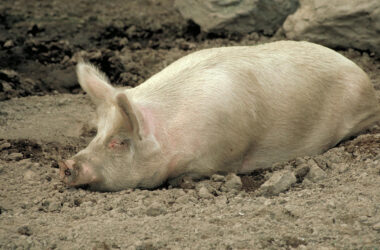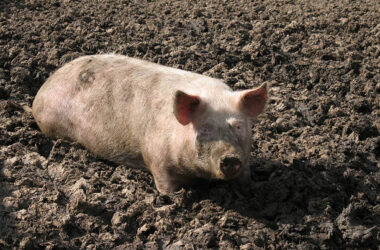Why Galla Goats Are Kenya’s Best-Kept Farming Secret
If you’re looking to start a livestock venture that can withstand Kenya’s increasingly unpredictable climate, here’s the cheat code you’ve been waiting for: Galla goats. These aren’t your average farm animals – they’re the heavy-hitters of Kenya’s arid and semi-arid regions, where traditional livestock often struggle to survive.
What makes these white, long-legged beauties stand out from the crowd? They’re basically the Swiss Army knife of livestock – drought-resistant, disease-tolerant, and impressively productive even when conditions get rough. While your neighbor’s conventional goats might be gasping during the dry season, your Galla herd will be casually browsing on brush that other animals can’t even reach.
What Exactly Are Galla Goats?
Galla goats, also known as Borana or Somali goats, are indigenous African champions primarily found in Northern Kenya. There are two main varieties – the Degyir and Degun – but both share the distinctive white coat and impressive stature that makes them immediately recognizable.
Unlike other local breeds that might have you chasing them across the landscape, Gallas have a remarkably chill temperament. They’re significantly easier to handle than varieties like the East African Goat, making your daily farm routine less of a workout and more of a pleasant interaction.
Free PDF DownloadSize Matters: The Physical Advantages
When it comes to Galla goats, bigger really is better. These animals are absolute units compared to typical indigenous breeds:
- Male bucks can reach heights of 75cm and weights up to 70kg
- Female does can achieve weights of approximately 55kg
To put that in perspective, they’re roughly three times the size of typical East African goats. This isn’t just impressive on paper – it translates directly to enhanced meat production, with their long bodies yielding more meat per bone than smaller varieties.
Survival Superstars: Why Gallas Thrive Where Others Don’t
The brutal truth about farming in Kenya’s challenging climate is that traditional livestock often perish during extended drought periods. Galla goats, however, seem to have missed that memo.
Their exceptional resilience to harsh conditions is perhaps their most valuable trait. These goats come equipped with superior resistance to gastrointestinal parasites and various infectious diseases that regularly devastate other goat populations. Their robust immune systems allow them to withstand the opportunistic infections that typically emerge during drought periods when animal health naturally deteriorates.
Climate Adaptation Champions
Climate change isn’t coming – it’s already here, and farmers need livestock that can handle it. Communities along the Kenya-Ethiopia border, particularly the Dassanach, have embraced this resilient breed as part of their adaptation strategy.
What makes Gallas so drought-ready?
- Their height advantage allows them to browse vegetation far off the ground
- They can digest twigs and brush that remain available even during severe dry periods
- They require significantly less water than cattle
- They produce less methane than cattle, making them environmentally friendlier too
The Production Powerhouse: Milk, Meat, and Money
Sure, survival is important – but you’re not just looking for animals that scrape by. You want production that pumps up your profits. Galla goats deliver here too, outperforming conventional breeds in several key areas.
Milk That Matters
Galla goats are dairy dynamos, with milk yields that significantly exceed those of ordinary goats kept by pastoralist communities. Their milk is nutritionally rich, packed with Vitamin A, protein, calcium, and phosphorus. This makes it:
- An excellent source for improving household nutrition
- Particularly valuable for children under five suffering from malnutrition
- A potential source of additional income through market sales
Meat Production That Maximizes Returns
The substantial size of Galla goats isn’t just for show – it’s money in the bank when it comes to meat production. Their large frame and long bodies allow for more meat relative to bone weight, increasing your marketable product from each animal.
Even better, they reach marketable weights faster than conventional breeds, allowing you to generate income more quickly from your livestock investments. This rapid return on investment can be critical for small-scale farmers looking to establish financial stability.
Reproduction That Rewards
One of the most impressive aspects of Galla goats is their reproductive efficiency. The breed demonstrates a higher twinning rate than standard varieties, enabling rapid herd growth. This characteristic proves particularly valuable for farmers rebuilding herds after drought-induced losses or those looking to scale their operations quickly.

Setting Up Your Galla Goat Farm: The Basics
One of the biggest advantages of Galla goat farming is that you don’t need fancy infrastructure or equipment to get started. Unlike many improved livestock breeds that require specialized housing, Gallas are relatively low-maintenance.
Housing: Keep It Simple
Forget complicated structures or expensive facilities. Galla goats thrive with basic shelter that protects them from extreme weather conditions and predators. This minimal infrastructure requirement makes them accessible to farmers with limited resources.
A simple structure with:
- Protection from rain and direct sun
- Good ventilation
- Security from predators
- Space for animals to move comfortably
That’s all you need to get started. Your wallet will thank you.
Feeding: Nature Does Most of the Work
Feeding Galla goats is surprisingly straightforward thanks to their browsing habits. These resourceful animals can effectively utilize various vegetation types, including wild brush that remains available even during drought conditions.
This versatility in feeding behavior significantly reduces the need for purchased feeds or extensive pasture development, making them economically viable for small-scale farmers. In more intensive production systems, you can optimize productivity with supplementary feeding during pregnancy and lactation, but even this is relatively minimal compared to other livestock.
Breeding and Management: Maximizing Your Herd’s Potential
While Gallas are naturally resilient and productive, smart management practices can take your farming operation to the next level.
Strategic Breeding for Maximum Results
Experienced farmers use these techniques to optimize breeding:
- Oestrus synchronization: Ensuring does come into heat simultaneously for more efficient breeding management
- Strategic planning: Aligning kidding with the rainy season when pastures are lush
- Proper buck rotation: Typically one male buck can serve approximately 30 does
- Genetic diversity: Sourcing new breeding males from different regions to prevent inbreeding
Does can remain productive in breeding programs for 3-4 years, though some may continue longer before being culled from the breeding stock.
Health Management: Prevention Is Better Than Cure
Despite their natural disease resistance, appropriate health management remains important. The breed is still susceptible to serious diseases like Contagious Caprine Pleuropneumonia (CCP), which can cause significant losses if not properly managed.
Implement these health practices:
- Regular preventive vaccination programs
- Scheduled deworming treatments
- Prompt treatment of any emerging health issues
- Risk management strategies, such as distributing herds across different locations
Success Stories: Galla Goat Implementation in Kenya
The proof is in the pudding – or in this case, in the successful implementation programs across Kenya that have transformed communities through Galla goat farming.
Government and NGO Initiatives
Several organizations have recognized the potential of Galla goats for improving rural livelihoods:
- The Pastoralist Community Initiative and Development Assistance (PACIDA) partnered with both Kenyan and Ethiopian governments to provide Galla goats to Dassanach communities along the border regions, distributing 198 goats (30 does and 3 bucks to each of six community groups).
- In Taita Taveta County, a substantial initiative delivered 2,250 Galla goats to local farmers as part of a collaboration between the County Government and the Food and Agriculture Organization (FAO). This distribution targeted 510 farmers organized into 22 groups across six geographic clusters.
- Narok County implemented a two-year project focused on disseminating improved goat management practices, targeting 200 local breeders directly and aiming to reach 2,000 pastoralists indirectly through knowledge transfer and breeding stock distribution.
Community-Based Success Models
Some of the most effective implementations have leveraged existing community structures:
- In Kapkitony, a village in northwestern Kenya, a mother-to-mother support group has successfully implemented Galla goat farming with support from Action Against Hunger.
- The clustering approach used in the Taita Taveta distribution program demonstrates how strategic geographic organization can maximize breeding efficiency while ensuring benefits reach a broader community base.
Getting Started: Your Galla Goat Farming Roadmap
Ready to jump into Galla goat farming? Here’s your step-by-step guide to getting started:
- Research and Planning
- Visit existing Galla goat farms in your region
- Determine the size of your operation based on available land and resources
- Calculate initial investment requirements and projected returns
- Sourcing Quality Stock
- Connect with reputable breeders or government distribution programs
- Select healthy animals with good conformation and breed characteristics
- Start with a manageable number (perhaps 10-20 does and 1-2 bucks)
- Setting Up Your Farm
- Prepare basic shelter structures
- Establish grazing areas and supplementary feeding plans
- Set up basic health management infrastructure
- Training and Knowledge Building
- Connect with agricultural extension officers for guidance
- Join farmer groups or cooperatives focused on goat production
- Participate in training programs offered by NGOs or government institutions
- Market Development
- Identify potential markets for meat, milk, and breeding stock
- Build relationships with local processors or buyers
- Consider value-addition options for milk products

The Economics: Why Your Wallet Will Love Galla Goats
Let’s talk money – because at the end of the day, farming is both a passion and a business. Galla goat farming offers lucrative returns for farmers who implement proper management practices.
Multiple Revenue Streams
Unlike some livestock operations that rely on a single product, Galla goat farming offers diverse income opportunities:
| Revenue Source | Potential Income | Time to Market |
|---|---|---|
| Breeding Stock | High value per animal | 8-12 months |
| Meat Production | Medium-high value | 6-10 months |
| Milk Sales | Steady income | Ongoing after kidding |
| Manure | Supplemental income | Continuous |
This diversification helps stabilize income throughout the year, reducing the economic vulnerability common in single-purpose livestock systems.
Impressive Return on Investment
The initial investment in Galla goat farming can be relatively modest compared to other livestock ventures, particularly given the minimal infrastructure requirements. With proper management, farmers can expect to recover their initial investment within 1-2 years, with profits increasing as the herd grows and reproduction compounds your returns.
Challenges and Solutions in Galla Goat Farming
No farming enterprise is without challenges, and it’s better to know what you might face before you start:
Challenge: Access to Quality Breeding Stock
Solution: Connect with government agriculture programs or established breeders who can supply pure Galla breeding stock. Join farmer cooperatives that might have better access to quality animals.
Challenge: Technical Knowledge Gaps
Solution: Seek training from agricultural extension officers, join farming groups with experienced Galla goat farmers, or participate in workshops offered by organizations promoting this breed.
Challenge: Market Access
Solution: Form marketing cooperatives with other Galla goat farmers to increase bargaining power, explore value addition for milk products, and build relationships with consistent buyers in urban markets.
Challenge: Disease Outbreaks
Solution: Implement strict biosecurity measures, follow vaccination schedules, and distribute your herd across different locations to mitigate the risk of total loss.
Why Galla Goat Farming Could Be Your Best Move
As Kenya continues to feel the effects of climate change, traditional farming approaches are becoming increasingly risky. Galla goat farming offers a practical, profitable alternative that works with—rather than against—our challenging environmental conditions.
The breed’s exceptional drought resistance, impressive productivity, and minimal resource requirements make it an ideal choice for farmers looking to build resilient agricultural livelihoods. From small-scale operations to commercial enterprises, these remarkable animals offer pathways to food security and economic stability.
Whether you’re a first-time farmer or looking to diversify an existing operation, Galla goats deserve your serious consideration. They’re not just livestock – they’re living proof that adaptation and resilience can be profitable.
Ready to transform your farming future with Galla goats? The growing institutional support from both governmental and non-governmental organizations means there’s never been a better time to get started. Your drought-defying, profit-generating herd awaits.










